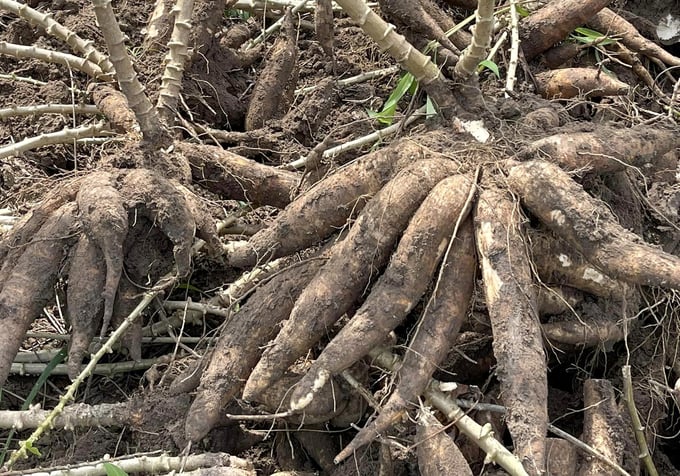May 16, 2025 | 09:45 GMT +7
May 16, 2025 | 09:45 GMT +7
Hotline: 0913.378.918
May 16, 2025 | 09:45 GMT +7
Hotline: 0913.378.918

The demand for cassava chip imports from China is declining sharply. Photo: Son Trang.
The demand for cassava chips from the Chinese market continues to show a significant decline, a trend that has been ongoing since 2023. According to China’s Customs Agency, in 2023, China imported over 5.61 million tons of cassava chips, valued at approximately 1.55 billion USD. This marked a 21% decrease in volume and a 24% drop in value compared to 2022.
Looking at the period from January to August 2024, China’s cassava chip imports have continued to fall dramatically. During these eight months, China imported only 1.89 million tons of cassava chips, with a total value of 482 million USD. This represents a 60% decrease in volume and a 63% drop in value compared to the same period in 2023. The main suppliers of cassava chips to China include Thailand, Vietnam, Laos, Cambodia, and Nigeria. While imports from Thailand, Vietnam, and Nigeria have experienced a substantial reduction, imports from Laos and Cambodia have shown an increase compared to the same period last year.
This sharp decrease in cassava chip imports is largely driven by a reduction in demand from Chinese factories that process cassava. Additionally, the low price of corn has led many factories to substitute cassava chips with corn.
China’s reduction in cassava chip imports has led to a significant decline in the overall volume of cassava chips imported from Vietnam. As a result, Vietnam has experienced a sharp drop in its cassava chip exports to the Chinese market this year. In the first 8 months of 2024, although Vietnam remains the second-largest supplier of cassava chips to China, the volume of cassava chips exported from Vietnam to China has decreased dramatically, reaching only 308.000 tons, valued at 79 million USD. This marks a substantial reduction of 47% in volume and 49% in value compared to the same period in 2023.
In comparison, Thailand, which is the largest exporter of cassava chips to China, also saw a significant decrease in exports during this period. Thai cassava chip exports to China amounted to 1.57 million tons, with a total value of 399 million USD. This represents a 62% decline in volume and a 65% drop in value compared to the same period in 2023. However, the decrease in Vietnam’s cassava chip exports was less severe than Thailand’s. As a result, Vietnam’s share of China’s total cassava chip imports has actually increased, while Thailand’s share has seen a sharp decline, dropping from 88% in the first eight months of 2023 to just 83% in the same period of 2024.
Due to the weakened market conditions, the prices have generally remained low throughout this year. For example, at the beginning of November, the FOB price for cassava chips exported from Quy Nhon port (Binh Dinh) to China was recorded at 245 USD/ton, while the price for cassava chips shipped to South Korea was slightly higher, at 295 USD/ton.
While the demand for cassava chips has sharply declined, the demand for cassava starch in the Chinese market has continued to grow. In the first 8 months of 2024, China imported 2.43 million tons of cassava starch, worth 1.27 billion USD, marking a 27% increase in volume and a 36% increase in value compared to the same period in 2023.
Over the past 8 months, China has primarily imported cassava starch from Thailand, Vietnam, Laos, Cambodia, and Indonesia. In the first 8 months of 2024, Vietnam was the second-largest supplier of cassava starch to China, with 930.000 tons valued at 457 million USD, an increase of 54% in volume and a 67% increase in value compared to the same period in 2023. Vietnam’s share of China’s total cassava starch imports has risen to 38%, up from 32% in the same period in 2023.
In the first eight months of 2024, Thailand continued to be the largest supplier of cassava starch to China, with 1.13 million tons worth 617.41 million USD. This marks a modest 7% increase in volume and a 14% increase in value compared to the same period in 2023. However, Thailand’s share of China’s total cassava starch imports has decreased to 47%, down from 56% in the first eight months of 2023.
In addition to Thailand, China has also increased its imports of cassava starch from Laos and Cambodia. Both countries have seen their market share grow compared to the same period last year. At the same time, China has reduced its cassava starch imports from Indonesia.

Some factories have reduced the purchase price of raw cassava. Photo: Son Trang.
Although cassava starch exports have increased significantly in the first 9 months of the year, the demand for this product from China has slowed since late September. One of the key reasons for this slowdown is the high inventory of cassava starch at the Qingdao port, which remains around 200.000 tons. As a result, Chinese traders have reduced the pace at which they are bringing goods to the Qingdao warehouse. This, coupled with a sharp decline in cassava chip exports, has contributed to a slowdown in cassava starch demand and is impacting the price of Vietnamese cassava.
The prices of cassava starch being offered at major Chinese ports are currently low, leading to a decrease in the price of Vietnamese cassava starch. At present, the price for cassava starch exported by Vietnamese factories is being quoted at 460 - 480 USD/ton (FOB) at Ho Chi Minh City port, which is a 20 USD per ton drop from early October. Cassava starch exported through Lang Son and Mong Cai border gates is also priced between 3.400-3.520 CNY per ton, down by 1.000 CNY per ton compared to earlier in the year.
According to the Import-Export Department (Ministry of Industry and Trade), since early October, more cassava has been arriving at processing factories, but the pace of cassava starch exports has been slowing. As a result, some factories in Central Vietnam and the Central Highlands have lowered their purchase prices for raw cassava. In early November, the price for purchasing raw cassava in several provinces in Central and Central Highlands regions ranged from 0.08 - 0.10 USD/kg, a decrease of 0.004 USD/kg compared to the beginning of October.
The most significant concern remains the cassava chip market. According to the Vietnam Cassava Association, information from cassava chip trading companies indicates that the market for cassava chips in the 2024-2025 season is expected to continue facing downward pressure on both prices and demand. As a result, some businesses with leftover cassava chips from the 2023-2024 season are being forced to liquidate their stocks at a loss in order to generate cash flow for the new 2024-2025 season.
With the remaining stock of cassava chips from the previous harvest, the drop in prices is making the decision to initiate purchases for the new season much more challenging. This is because it involves a complex balancing act, both in terms of financial considerations and pricing strategy. Several cassava chip warehouse owners, particularly those who supply to ethanol production plants, are reportedly planning to release their old crop stock at relatively low prices, likely below 0.22 USD/kg. This pricing decision comes amid expectations that the market for cassava chips could continue to decline, driven by the ongoing drop in the price of fresh cassava roots.
According to the General Department of Customs, Vietnam’s cassava exports saw a sharp decline in September 2024 due to the impact of heavy rains and floods, as well as slower demand from China. Specifically, in September 2024, Vietnam exported 121.000 tons of cassava and cassava products, worth 57 million USD, representing a 37% decrease in volume and a 35% decrease in value compared to August 2024. Compared to September 2023, exports dropped by 54% in volume and 54% in value. For the first nine months of 2024, cumulative exports of cassava and cassava products totaled 1.91 million tons, valued at 879 million USD, marking a 10% decrease in volume and a 1.4% decline in value compared to the same period in 2023.
Translated by Phuong Linh

(VAN) Japan's efforts to lower the price of rice through the release of its stockpile may finally be making some progress, albeit at a snail's pace.

(VAN) U.S. tariffs are not only a 'shock', but also an opportunity for Vietnamese businesses to renew their mindset toward comprehensive development.

(VAN) As Bac Giang lychee enters the harvest season, Minister Do Duc Duy expects that the fruit will contribute greatly to agricultural exports due to standardized production and deep processing.

(VAN) Consumers have shown a preference for free-range eggs, but those farming systems are more vulnerable to biosecurity risks like bird flu.
/2025/05/09/5701-1-184335_301.jpg)
(VAN) Vietnam’s eel exports nearly doubled thanks to a mud-free farming model, opening up new prospects while still facing numerous barriers related to international standards.

(VAN) Minister Do Duc Duy warned that if production is not professionalized and supply chains are not transparent, the U.S. market could become a growth bottleneck.

(VAN) Delegating surveillance responsibilities to local authorities is a cost-saving and efficiency-boosting measure that removes a key bottleneck for enterprises, according to Director General Duong Tat Thang.